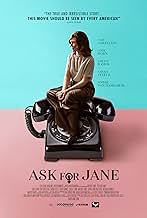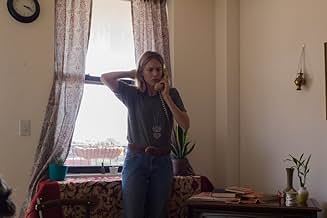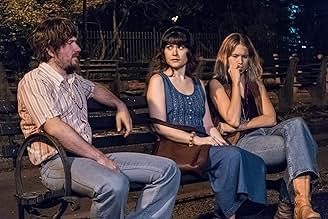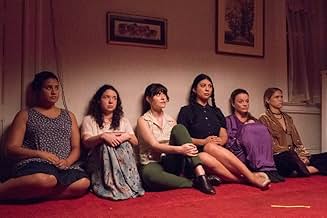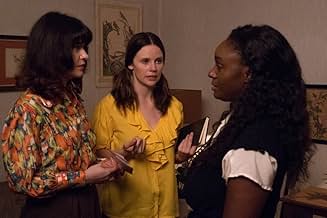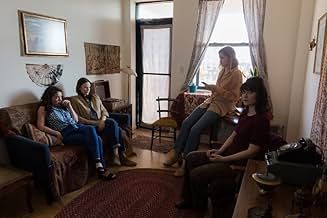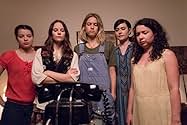Ajouter une intrigue dans votre langueA group of determined Midwestern women begin providing safe but illegal abortions in this 1960s period drama based on a true story.A group of determined Midwestern women begin providing safe but illegal abortions in this 1960s period drama based on a true story.A group of determined Midwestern women begin providing safe but illegal abortions in this 1960s period drama based on a true story.
- Réalisation
- Scénario
- Casting principal
- Récompenses
- 4 victoires au total
Avis à la une
A different movie and was really worth watching. I liked sets and designs.
I was very engrossed in watching Ask for Jane. Though I am of the same generation, aware and well read, I didn't know about the Janes. I wonder whether publicity about them ever reached the East Coast. I had to keep reminding myself that the film took place in the Midwest, thereby making the plight of women more of a struggle than in more progressive cities on both Coasts. Their location also explained the way the women looked, which puts a positive spin on it, rather than saying the director screwed up. Some of the outfits they wore and hair styles were not very realistic. In fact, one was downright distracting: one of the main characters, Rose, had a dye job, in which the bottom three inches or her hair were reddish while the rest was dark brown. To my knowledge this type of hombre effect in hair coloring did not become a popular style until after the Millennium.
But hair and clothes aside, the film is powerful in its portrayal of dedicated young women who felt strongly enough about helping women, including themselves, to risk being arrested and convicted of a crime. Ultimately the film is about the oppression of women, and how the right to control one's own body, and even to know and understand one's body, had always been in the hands of men.
The film was strong in showing how in most situations, the women were always expected to defer to men, whether their husbands, fathers, doctors or clergy. Despite coming from relatively conservative backgrounds, the women portrayed, the Janes as they were known, were brave, noble and revolutionary. I hope they got (or get) at least some of the recognition they deserved.
But hair and clothes aside, the film is powerful in its portrayal of dedicated young women who felt strongly enough about helping women, including themselves, to risk being arrested and convicted of a crime. Ultimately the film is about the oppression of women, and how the right to control one's own body, and even to know and understand one's body, had always been in the hands of men.
The film was strong in showing how in most situations, the women were always expected to defer to men, whether their husbands, fathers, doctors or clergy. Despite coming from relatively conservative backgrounds, the women portrayed, the Janes as they were known, were brave, noble and revolutionary. I hope they got (or get) at least some of the recognition they deserved.
This film takes you back to 1969 to remind you what life was like in the pre roe days. But it's more than that. How do some college women become abortion providers? How do you find a Doctor willing to go to jail? How do you let women know that you have a service, without going afoul of the police? Exactly how condescending were doctors to women back then? This film deftly interweaves multiple stories to give a full picture. And it has a great ensemble cast.
It's a shame that the issue of abortion is still one that plagues the political dialogue. With the recent law passed in Alabama, we are one step closer to the nightmarish implications women faced in pre-Roe v. Wade America, where obtaining an abortion was difficult, painful, and often impossible. The Jane Collective, the basis for "Ask for Jane", was one of the groups who defied the laws, helping women obtain safe abortions and providing a support network. Unfortunately, the brave efforts of these women has not received the film adaptation they deserved in "Ask for Jane".
For starters, the main thing holding this film back is it's budget. According to what I can find online, the film had a budget of $250,000. Even when considering that shoestring budget, this film is incredibly lacking. Films like "Thunder Road" (with a budget of $200,000) and "Upstream Color" ($50,000) look leagues better than "Ask for Jane". Perhaps that is because, unlike those other films (or most low-budget films, for that matter), "Ask for Jane" is a period film, set in the late 60s/early 70s in Chicago. In my initial viewing, I wasn't aware of the exact budget, but began to notice that 90% of the scenes were shot indoors, and the framing of the few outdoor scenes was very tight and claustrophobic. I soon realized that this is because if the shots were any wider, we'd catch the modern stores and cars they were walking past. I will give the filmmakers credit that I wasn't able to catch any Starbucks or SUVs in the background. However, with limited resources, a film should be able to trick it's viewers into not seeing it's shortcomings. This film fails in that respect, with the cheap synthetic costumes, hastily decorated starter apartments, and all cars or other expensive spectacle occurring offscreen (save for one powder-blue Oldsmobile the film was able to secure).
Even if the budget was sufficient for this film, there were still other issues to overcome. A rushed feel, a lack of coverage, and a script that has characters randomly being introduced and dropped until almost the very end of the 108-minute film kill the pacing of the project.
The tone of the film is also over the place. Abortion is probably one of the most difficult subjects to tackle in storytelling, and "Ask for Jane" can't decide what tone it wants to take. In some scenes, abortion is treated with solemn urgency. In others, it's treated with blase flippancy ("My parents are really religious", one pregnant character cries. "So just get an abortion", says her roommate, with the significance of telling her to run to the supermarket to get milk.) In one very strange moment in a montage, abortion is played for comedy, when a frazzled mother of four chokes out "I CAN'T have another."
For the most part, the performances were fine. The main seven women portrayed their roles with conviction, and the peripheral characters fulfilled their purposes. The only weak link was main character Rose's fiance, who woodenly leaves her after her involvement in The Jane Collective would potentially ruin his chances of running for "office" (what office or political platform he takes, the movie doesn't seem to really care about). His main problem is that he doesn't seem convincingly upset about Rose's part-time job as an abortionist, so his decision to leave her doesn't make any sense.
The biggest shame of "Ask for Jane" is that I wish a better film would be made about The Jane Collective. This group helped thousands of women reclaim their lives and their bodily autonomy. However, the filmmakers seem to be mistaken that historical importance is a substitute for competent production design, nuanced direction, or defined characters.
For starters, the main thing holding this film back is it's budget. According to what I can find online, the film had a budget of $250,000. Even when considering that shoestring budget, this film is incredibly lacking. Films like "Thunder Road" (with a budget of $200,000) and "Upstream Color" ($50,000) look leagues better than "Ask for Jane". Perhaps that is because, unlike those other films (or most low-budget films, for that matter), "Ask for Jane" is a period film, set in the late 60s/early 70s in Chicago. In my initial viewing, I wasn't aware of the exact budget, but began to notice that 90% of the scenes were shot indoors, and the framing of the few outdoor scenes was very tight and claustrophobic. I soon realized that this is because if the shots were any wider, we'd catch the modern stores and cars they were walking past. I will give the filmmakers credit that I wasn't able to catch any Starbucks or SUVs in the background. However, with limited resources, a film should be able to trick it's viewers into not seeing it's shortcomings. This film fails in that respect, with the cheap synthetic costumes, hastily decorated starter apartments, and all cars or other expensive spectacle occurring offscreen (save for one powder-blue Oldsmobile the film was able to secure).
Even if the budget was sufficient for this film, there were still other issues to overcome. A rushed feel, a lack of coverage, and a script that has characters randomly being introduced and dropped until almost the very end of the 108-minute film kill the pacing of the project.
The tone of the film is also over the place. Abortion is probably one of the most difficult subjects to tackle in storytelling, and "Ask for Jane" can't decide what tone it wants to take. In some scenes, abortion is treated with solemn urgency. In others, it's treated with blase flippancy ("My parents are really religious", one pregnant character cries. "So just get an abortion", says her roommate, with the significance of telling her to run to the supermarket to get milk.) In one very strange moment in a montage, abortion is played for comedy, when a frazzled mother of four chokes out "I CAN'T have another."
For the most part, the performances were fine. The main seven women portrayed their roles with conviction, and the peripheral characters fulfilled their purposes. The only weak link was main character Rose's fiance, who woodenly leaves her after her involvement in The Jane Collective would potentially ruin his chances of running for "office" (what office or political platform he takes, the movie doesn't seem to really care about). His main problem is that he doesn't seem convincingly upset about Rose's part-time job as an abortionist, so his decision to leave her doesn't make any sense.
The biggest shame of "Ask for Jane" is that I wish a better film would be made about The Jane Collective. This group helped thousands of women reclaim their lives and their bodily autonomy. However, the filmmakers seem to be mistaken that historical importance is a substitute for competent production design, nuanced direction, or defined characters.
A story that must be told and addressed always. Shows how this crap still has to be fought. Bible thumpers don't know how to mind their business and keep their religion and politics to theirselves amongst their own believers. Church and state still.mingle on daily. Just stuck living in the past forever in make believe Bible land. This is a medical procedure that lies in the hands and choice of the women who CHOOSE this for themselves and their well being. It is Not the business of the holier than thou hypocrite sinners who complain at every turn and provide zero support to those they want to force into their ways. Not to mention do the same exact stuff in the dark undercover. Ok sorry im a little touchy about this subject.
Meilleurs choix
Connectez-vous pour évaluer et suivre la liste de favoris afin de recevoir des recommandations personnalisées
- How long is Ask for Jane?Alimenté par Alexa
Détails
- Durée1 heure 48 minutes
- Couleur
Contribuer à cette page
Suggérer une modification ou ajouter du contenu manquant

Lacune principale
By what name was Ask for Jane (2018) officially released in India in English?
Répondre

